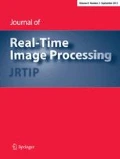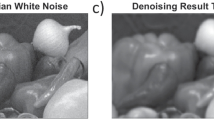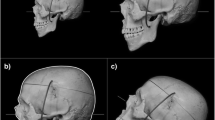Abstract
Gradient vector flow (GVF) is a feature-preserving spatial diffusion of image gradients. It was introduced to overcome the limited capture range in traditional active contour segmentation. However, the original iterative solver for GVF, using Euler’s method, converges very slowly. Thus, many iterations are needed to achieve the desired capture range. Several groups have investigated the use of graphic processing units (GPUs) to accelerate the GVF computation. Still, this does not reduce the number of iterations needed. Multigrid methods, on the other hand, have been shown to provide a much better capture range using considerable less iterations. However, non-GPU implementations of the multigrid method are not as fast as the Euler method when executed on the GPU. In this paper, a novel GPU implementation of a multigrid solver for GVF written in OpenCL is presented. The results show that this implementation converges and provides a better capture range about 2–5 times faster than the conventional iterative GVF solver on the GPU.








Similar content being viewed by others
References
Advanced Micro Devices. AMD Accelerated Parallel Processing OpenCL Programming Guide. Technical Report November, 2013. http://developer.amd.com/wordpress/media/2013/07/AMD_Accelerated_Parallel_Processing_OpenCL_Programming_Guide-rev-2.7.pdf. Accessed 8 Aug 2013
Alvarado, R., Tapia, J.J., Rolón, J.C.: Medical image segmentation with deformable models on graphics processing units. J. Supercomput. 68(1), 339–364 (2013)
Bauer, C., Bischof, H.: A novel approach for detection of tubular objects and its application to medical image analysis. In: Proceedings of the 30th DAGM Symposium on Pattern Recognition, pp. 163–172. Springer, New York (2008)
Bauer, C., Bischof, H.: Extracting curve skeletons from gray value images for virtual endoscopy. In: Proceedings of the 4th International Workshop on Medical Imaging and Augmented Reality, pp. 393–402. Springer, New York (2008)
Bolz, J., Farmer, I., Grinspun, E., Schröder, P.: Sparse matrix solvers on the GPU: conjugate gradients and multigrid. In: Proceedings of ACM Transactions on Graphics (TOG), Proceedings of ACM SIGGRAPH 2003, vol. 22, issue 3, pp. 917–924 (2003)
Eidheim, O.C., Skjermo, J., Aurdal, L.: Real-time analysis of ultrasound images using GPU. Int. Congr. Ser. 1281, 284–289 (2005)
Grossauer, H., Thoman, P.: GPU-based multigrid: real-time performance in high resolution nonlinear image processing. Comput. Vis. Syst. 5008, 141–150 (2008)
Guo, Y., Lu, C.-C.: Multi-modality image registration using mutual information based on gradient vector flow. In: Proceedings of 18th International Conference on Pattern Recognition (ICPR’06), IEEE, pp. 697–700 (2006)
Han, X., Xu, C., Prince, J.L.: Fast numerical scheme for gradient vector flow computation using a multigrid method. Image Process. IET 1(1):48–55 (2007)
Hassouna, M.S., Farag, A.A.: On the extraction of curve skeletons using gradient vector flow. In: Proceedings of IEEE 11th International Conference on Computer Vision, IEEE, pp. 1–8 (2007)
He, Z., Kuester, F.: GPU-based active contour segmentation using gradient vector flow. In: Proceedings of Advances in Visual Computing, pp. 191–201. (2006)
Kass, M., Witkin, A., Terzopoulos, D.: Snakes: active contour models. Int. J. Comput. Vis. 1(4), 321–331 (1988)
NVIDIA. OpenCL Best Practices Guide. Technical report, 2010. http://www.nvidia.com/content/cudazone/CUDABrowser/downloads/papers/NVIDIA_OpenCL_BestPracticesGuide.pdf. Accessed 8 Aug 2013
Ray, N., Acton, S.T.: Motion gradient vector flow: an external force for tracking rolling leukocytes with shape and size constrained active contours. IEEE Trans. Med. Imaging 23(12):1466–1478 (2004)
Smistad, E., Elster, A.C., Lindseth, F.: GPU-based airway segmentation and centerline extraction for image guided bronchoscopy. In: Proceedings of Norsk Informatikkonferanse, pp. 129–140. Akademika forlag (2012)
Smistad, E., Elster, A.C., Lindseth, F.: Real-time gradient vector flow on GPUs using OpenCL. J. Real-Time Image Process. pp. 1–8 (2012)
Smistad, E., Elster, A.C., Lindseth, F.: GPU accelerated segmentation and centerline extraction of tubular structures from medical images. Int. J. Comput. Assist. Radiol. Surg. 9(4), 561–575 (2014)
Smistad, E., Lindseth, F.: A new tube detection filter for abdominal aortic aneurysms. In: Proceedings of MICCAI 2014 Workshop on Abdominal Imaging: Computational and Clinical Applications (2014)
Xu, C., Prince, J.L.: Snakes, shapes, and gradient vector flow. IEEE Trans. Image Process. 7(3), 359–369 (1998)
Zheng, Z., Zhang, R.: A fast GVF snake algorithm on the GPU. Res. J. Appl. Sci. Eng. Technol. 4(24), 5565–5571 (2012)
Author information
Authors and Affiliations
Corresponding author
Rights and permissions
About this article
Cite this article
Smistad, E., Lindseth, F. Multigrid gradient vector flow computation on the GPU. J Real-Time Image Proc 12, 593–601 (2016). https://doi.org/10.1007/s11554-014-0466-2
Received:
Accepted:
Published:
Issue Date:
DOI: https://doi.org/10.1007/s11554-014-0466-2




